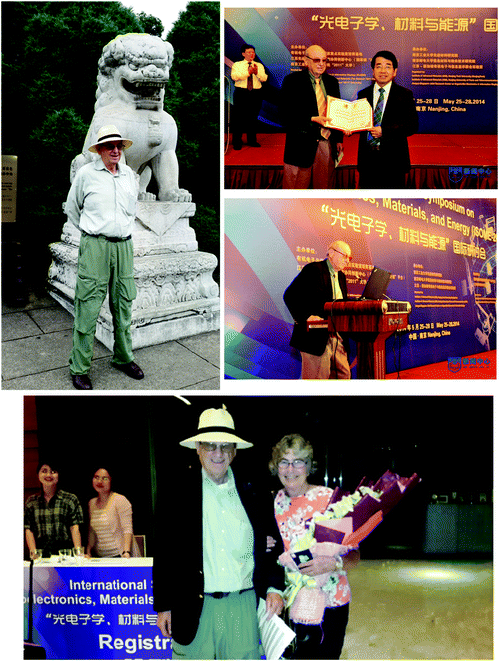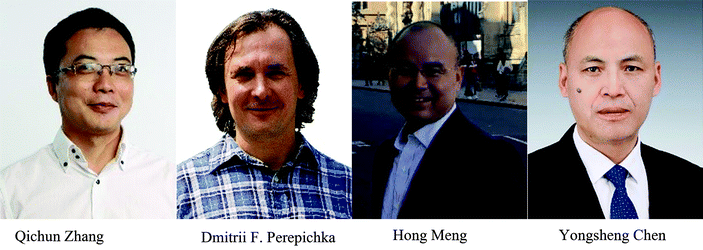Fred Wudl. A giant in π-conjugated materials
Qichun
Zhang
a,
Dmitrii F.
Perepichka
b,
Hong
Meng
c and
Yongsheng
Chen
d
aDepartment of Materials Science and Engineering, City University of Hong Kong, Hong Kong, 999077, China
bDepartment of Chemistry, McGill University, 801 Sherbrooke str West, Montreal H3A 0B8, Qc, Canada
cSchool of Advanced Materials, Peking University, Shenzhen Graduate School, Shenzhen, 518055, China
dKey Laboratory of Functional Polymer Materials of Ministry of Education, College of Chemistry, Nankai University, Tianjin, 300350, P. R. China
Wudl's work continues to inspire many scientists to push the advance of materials chemistry. In this themed issue, you will find 24 reviews, communications and full articles covering the synthesis of new conjugated molecules and polymers, the study of structure–properties relationships, and applications in various devices including solar cells, organic field-effect transistors (OFETs), organic light-emitting diodes (OLEDs) and sensors.
Many papers in this themed issue evolve from Fred's early work in materials chemistry and have been presented by many of his former coworkers and colleagues. The diversity of the presented contributions reflect that of Fred's own career. These include the review on azaacenes by Zhang and Zhang (DOI: 10.1039/C9QM00656G), propellant-based electron acceptors by Zhang et al. (DOI:10.1039/D0QM00279H), anthracene-based liquid crystals by Meng et al. (DOI: 10.1039/D0QM00305K), stable radicals by Zheng et al. (DOI: 10.1039/D0QM00122H), and polymers by Wei and Wang (DOI: 10.1039/D0QM00309C); and papers on conjugated polyelectrolytes by Nguyen et al. (DOI: 10.1039/D0QM00073F) and by Chiechi et al. (DOI: 10.1039/D0QM00278J), pyridine/selenophene copolymers by Yang et al. (DOI: 10.1039/C9QM00739C), 2D perovskites by Dou et al. (DOI: 10.1039/D0QM00233J), chemical and biological sensors based on OFETs by Miao et al. (DOI: 10.1039/D0QM00202J), non-fullerene acceptor by Chen et al. (DOI: 10.1039/D0QM00287A), thermally activated delayed fluorescence (TADF) by Bryce, Monkman et al. (DOI: 10.1039/D0QM00429D), donor–acceptor co-crystals by Coropceanu, Brédas et al. (DOI: 10.1039/D0QM00420K) and by Perepichka et al. (DOI: 10.1039/D0QM00500B), doping of organic and perovskite semiconductors by Chabinyc et al. (DOI: 10.1039/D0QM00442A), rylene diimides by Guldi, Prato et al. (DOI: 10.1039/D0QM00407C). One of these papers builds on Fred's famous isothianaphthene motif to create new n-type semiconductors and has been co-authored by Fred (DOI: 10.1039/D0QM00137F).
During the preparation of this themed issue, we received a hugely enthusiastic response from researchers in the organic electronics community, which was not surprising given Fred's pioneering role in the field. We hope that you will enjoy reading through this issue.
Although Professor Wudl has now retired, he remains an active member of the scientific community (Fig. 1). His “what's the story?” (addressed daily to his students and post-docs) will be remembered for many years. Happy Birthday, Fred, and many more to come!
 | ||
| Fig. 1 Professor Fred Wudl at the International Symposium on Optoelectronics, Materials, and Energy (iSOME-2014) in Nanjing 2014, and the following social activities with his wife Dr Linda Wudl. | ||
| This journal is © the Partner Organisations 2020 |

